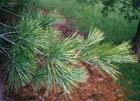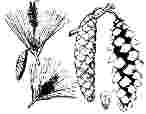 Shoot of an ornamental specimen (Seattle, USA) showing foliage and twig [C.J. Earle].  Foliage on an ornamental tree in Seattle (USA) [C.J. Earle, Feb-1999].  White pine (2). |
Pinus strobus Linnaeus 1753
Common NamesEastern white pine, northern white pine, pin blanc (5); white pine.Taxonomic notesSyn: Pinus chiapensis (Martínez) Andresen, P.strobus var. chiapensis Martínez, Strobus strobus (Linnaeus) Small (5). One variety, chiapensis (see Remarks).DescriptionTrees to 30-67 m tall and 100-180 cm in diameter, straight; crown conic, becoming rounded to irregular or flattened. Bark darkening and thickening as tree ages, becoming gray-brown, deeply furrowed with broad ridges of irregularly rectangular, purple-tinged scaly plates. Branches whorled, spreading-upswept; twigs slender, pale red-brown, glabrous or pale puberulent, aging gray, ±smooth. Buds ovoid-cylindric, light red-brown, 0.4-0.5 cm, slightly resinous. Needles 5 per fascicle, spreading to ascending, persisting 2-3 years, 6-10 cm x 0.7-1 mm, straight, slightly twisted, pliant, deep green to blue-green, pale stomatal lines evident only on adaxial surfaces, margins finely serrulate, apex abruptly acute to short-acuminate; sheath 1-1.5 cm, shed early. Staminate cones numerous, ellipsoid, 10-15 mm, yellow. Ovulate cones maturing in 2 years, shedding seeds and falling soon thereafter, clustered, pendent, symmetric, cylindric to lance-cylindric or ellipsoid-cylindric before opening, ellipsoid-cylindric to cylindric or lance-cylindric when open, (7)8-20 cm, gray-brown to pale brown, with purple or gray tints, stalks 2-3 cm; apophyses slightly raised, resinous at tip; umbo terminal, low. Seeds compressed, broadly obliquely obovoid; body 5-6 mm, tapering at both ends, red-brown mottled with black; wing 1.8-2.5 cm, pale brown. 2n=24 (2, 5).RangeCanada: Newfoundland, Nova Scotia, New Brunswick, Prince Edward Island, Québec, Ontario, and Manitoba; France: St. Pierre and Miquelon; and USA: All states E from Minnesota, Iowa, Illinois, Kentucky, Tennessee and Georgia to the Atlantic Ocean (excepting Florida); the variety in Mexico and Guatemala. Found at sea level in the N, and up to 1500 m in the S. Prefers well-drained soils and a cool, humid climate. Forms mixed stands with Tsuga canadensis, Quercus sp., or Fraxinus americana. (2, 5).Big TreeDiameter 150 cm, height 61 m, crown spread 16 m; also, diameter 163 cm, height 55 m, crown spread 20 m. Locality: Marquette, MI (4). Larger specimens are recorded historically.OldestGiven the size and habitat of this pine, ages exceeding 400 years are doubtless possible.DendrochronologyEthnobotanyP. strobus was a valued source of naval stores in the 1700s, and large tracts were once reserved for exploitation by the Royal Navy (5). Vast stands were logged in the 1700s and 1800s for masts, buildings, and furniture (2). Because of extensive lumbering, few uncut stands remain (5). It is an important horticultural species (2).ObservationsSeen in Killarney Provincial Park, Ontario. Old-growth stands are said to remain in Algonquin Provincial Park, Ontario, and in a few other locales.RemarksMast years at 3 to 5 year intervals provide a seed crop important to wildlife (2). White pine blister rust (Cronartium ribicola), an introduced fungal disease, has decimated formerly extensive stands of this and certain other white pines (3).Pinus strobus var. chiapensis appears to be as Martínez saw it: a clinal variant that, compared to the type variety, has finer leaves, different resin canal distribution, and heavier cones when cones of similar sizes are compared (5). Eastern white pine is the provincial tree of Ontario and the state tree of Maine and Michigan (5). Citations(1) Burns, R.M. and B.H. Honkala. 1990. Silvics of North America, Vol. 1, Conifers. Washington DC: U.S.D.A. Forest Service Agriculture Handbook 654. http://willow.ncfes.umn.edu/silvics_manual/Table_of_contents.htm.(2) Elias, Thomas S. 1987. The complete trees of North America; a field guide and natural history. NY: Gramercy Publ. Co. (3) Little, Elbert L. Jr. 1980. The Audubon Society field guide to North American trees. New York: Alfred A. Knopf. (4) American Forests. 1996. The 1996-1997 National Register of Big Trees. Washington, DC: American Forests. (5) Kral in Flora of North America online. See also: The FEIS database. Anantha M. Prasad and Louis R. Iverson. 1999. A Climate Change Atlas for 80 Forest Tree Species of the Eastern United States. http://www.fs.fed.us/ne/delaware/atlas/. Delaware, Ohio: USFS Northeastern Research Station. |
back | Pinus | Pinaceae | home This page is from the Gymnosperm Database
|